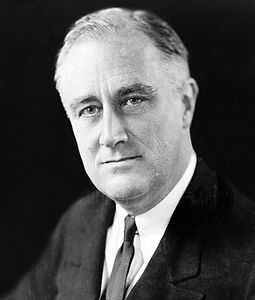1944 Democratic National Convention
| 1944 Presidential Election | |
|---|---|
  Nominees Roosevelt and Truman | |
| Convention | |
| Date(s) | July 19 - July 21 |
| City | Chicago, Illinois |
| Venue | Chicago Stadium |
| Candidates | |
| Presidential nominee | Franklin D. Roosevelt of New York |
| Vice Presidential nominee | Harry Truman of Missouri |
The 1944 Democratic National Convention was held at the Chicago Stadium in Chicago, Illinois from July 19 to July 21, 1944. The convention resulted in the nomination of President Franklin D. Roosevelt for an unprecedented fourth term. Senator Harry S. Truman of Missouri was nominated for Vice President. Including Roosevelt's nomination for the vice-presidency in 1920, it was the fifth time Roosevelt that had been nominated on a national ticket. The keynote address was given by Governor Robert S. Kerr of Oklahoma, in which he "gave tribute to Roosevelt's war leadership and new deal policies."[1]
Balloting
The only ballot went thusly:
| Candidate | 1st ballot |
|---|---|
| Franklin D. Roosevelt | 1,086 (92.35%) [2] |
| Harry F. Byrd | 89 (7.56%) |
| James A. Farley | 1 (0.09%) |
The vice-presidential nomination
Despite the obvious physical decline in the President's appearance, as well as rumors of secret health problems, Roosevelt's fourth nomination as President was largely unchallenged. The contention lay in the vice-presidential nomination. Henry Wallace had been elected Vice President in 1940. He was FDR's preferred choice and was very popular with rank and file Democratic voters. However, conservative Party leaders, such as James F. Byrnes, strongly opposed his renomination. They regarded Wallace as being too far to the left, too "progressive" and too friendly to labor to be next in line for the Presidency. Outgoing Democratic National Committee chairman Frank C. Walker, incoming chairman Robert E. Hannegan, party treasurer Edwin W. Pauley, strategist Edward J. Flynn, Chicago Mayor Edward Joseph Kelly and lobbyist George E. Allen all wanted to keep Wallace off the ticket. Their group was deemed by Allen as "The Conspiracy of the Pure in Heart."[3] They privately told Roosevelt that they would fight Wallace's renomination, and they proposed Missouri Senator Harry Truman as FDR's new running mate. Truman had entered the Senate in January 1935 with a reputation as an errand runner and ("the senator from Pendergast") and had become well known during the war as the chairman of a Senate investigating committee. Roosevelt personally liked Wallace and knew little about Truman, but he reluctantly agreed to accept Truman as his new running mate to preserve party unity.
President Roosevelt traveled to the South Pacific in order to discuss military strategy with General Douglas MacArthur, and thus didn't attend the convention. This was the last time that a presidential nominee failed to attend a national convention during the 20th century. Even so, many delegates refused to abandon Wallace. In the first ballot, Wallace led with 429.5 votes and Truman got 319.5 votes. But Wallace was 159.5 votes short of a majority. The party leaders went to work talking to delegates, cutting deals and applying pressure to persuade them to select Truman. Truman won the second ballot by 1031 votes to 105. The maneuverings over the 1944 vice presidential nomination proved to be historic, as FDR died in April 1945, and Truman, not Wallace, thus became the nation's 33rd President.[4]
Robert E. Hannegan, the chairman of the Democratic National Committee who had worked feverishly to secure Truman's nomination, later said he wanted his tombstone inscribed with the words "Here lies the man who stopped Henry Wallace from becoming President of the United States."[5]
| Candidate | 1st ballot | 2nd ballot (before shifts) | 2nd ballot (after shifts) |
|---|---|---|---|
| Harry S. Truman MO | 319.5 | 477.5 | 1,031 |
| Henry A. Wallace IA | 429.5 | 473 | 105 |
| John H. Bankhead II AL | 98 | 23.5 | 0 |
| Scott W. Lucas IL | 61 | 58 | 0 |
| Alben W. Barkley KY | 49.5 | 40 | 6 |
| J. Melville Broughton NC | 43 | 30 | 0 |
| Paul V. McNutt IN | 31 | 28 | 1 |
| Prentice Cooper TN | 26 | 26 | 26 |
| Scattering | 118.5 | 20 | 7 |
In Popular Culture
The events of the Chicago convention were dramatized in the second episode of the popular Showtime documentary series Oliver Stone's Untold History of the United States which looks at how close Henry Wallace came to the US Presidency.
References
- ↑ Kerr Exhibit, 1944 Democratic National Convention
- ↑ For the Fourth Time - TIME
- ↑ McCullough, David (1992). Truman, pp373-378. New York: Simon & Schuster. ISBN 978-0-671-86920-5
- ↑ "Henry Agard Wallace, 33rd Vice President (1941-1945)"
- ↑ What If 2? Edited by Robert Crowley. 'The Presidency of Henry Wallace', by James Chace, page 394
Literature
- Robert H. Ferrell, Choosing Truman: The Democratic Convention of 1944 (1994), Columbia: University of Missouri Press, ISBN 0-8262-1308-1
| Preceded by 1940 |
Democratic National Conventions | Succeeded by 1948 |
| ||||||||||||||||||||||||||||||||||||||||||||||||||||||||||||||
| ||||||||||||||||||||||||||||||||||||||||||
| ||||||||||||||||||||||||||||||||||||||||||